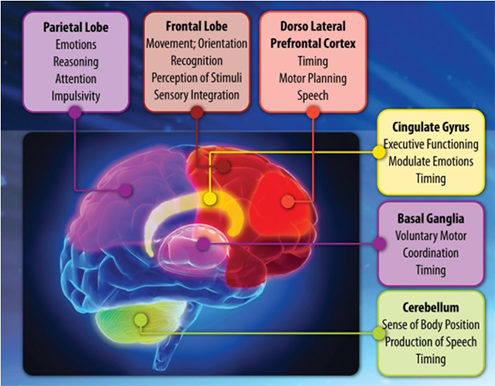Brain Advancement Center, LLC
Office Hours: Mon-Fri 9 AM – 5 PM
Clinician Hours: Mon-Fri 9 AM – 6 PM or by appointment
Sat: By appointment only Sun: Closed
NOW TAKING NEW CLIENTS
ALL AGES AND STAGES
Call Us
Treating Pediatric & Adult Neurological Conditions
What is Interactive Metronome (IM)
Interactive Metronome® (IM) is an evidence-based training and assessment tool. IM is shown to improve cognition, attention, focus, memory, speech/language, executive functioning, comprehension, as well as motor & sensory skills.
How IM Affects the Brain
The Interactive Metronome® (IM) is an evidence-based, engaging therapeutic modality used by professionals who work with pediatric and adult patients with neurological conditions that affect cognitive and motor functioning.
IM is both an assessment and treatment tool and has shown improvements in the following areas of the brain.


Evidence-Based Training
The Interactive Metronome® (IM) challenges your clients to synchronize a range of whole-body exercises to a beat. A score is provided in milliseconds.
IM's game-like features engage the client with auditory and visual guidance and provide real-time feedback while encouraging him/her to improve their scores.
How IM Training Works
-
Pediatric Conditions
IM training can work for people from ages 1 to 100; however, some conditions affect children differently, and many lifelong conditions that can have a major impact on our adult brains actually begin in childhood.
In addition to the normal stress of puberty, starting each new school year, making friends, and growing up in our ever-changing world, children may also fall victim to a variety of developmental delays and neuromuscular conditions.
Disorders such as Autism, SPD, ADHD, and Dyslexia can keep children from enjoying the happy, carefree life they deserve. Working with children takes a special type of training, and that is where IM training can help!
IM training is a patented, flexible program that allows clients to synchronize their internal clocks. By restoring the critical skill of Neurotiming, children can effectively rewire their brain to work more efficiently and effectively. Neuro-timing has been linked to everything from autism to brain injuries to ADHD.
-
Dyslexia
Dyslexia is the most common reading disability, but it is unique from other reading difficulties because it is not just a receptive language-based learning disability; it also affects children's expressive language skills, and in some cases, the ability to recognize voices and sounds. It can lead to difficulty with speech and reading, mirrored handwriting, and inability to attend amidst distractions.
Reading and writing are very important to childhood development. Trouble reading can make it hard for children to be exposed to new thoughts and materials, which is often amplified by ADHD and the language disorders associated with dyslexia.
Timing in the brain, or Neurotiming, is critical to reading, speech, language, and cognitive function. Timing is a domain-general mechanism that basis for attention, working memory and processing speed, all of which are critical for reading and language development. While domain-general might sound foreign, it is actually a principle at play right now in your brain.
Much of our lives revolve around timing. Reading relies on timing. Sleep cycles rely on brain timing. Speaking is all about pauses and timing; even baking cookies is a matter of timing. This timing in the brain has been shown to be deficient in several common conditions, including dyslexia.
IM is the only training program that improves timing in the brain in an organized, systematic, flexible, and engaging format.
Research shows that combining whole-body movements with cognitive tasks leads to overall better outcomes. IM is a patented and unique training tool that challenges thinking and movement simultaneously, providing real-time millisecond feedback to help synchronize the body's "internal clock."
In fact, a study from Baylor University reveals that students who received just 15 minutes of IM training, four days a week in addition to language and reading intervention demonstrated significant improvement in reading rate, fluency, and comprehension over students who just received language and reading instruction.
-
Attention Deficit Hyperactivity Disorder (ADHD)
It is essential that children be able to filter out distractions, hold information in working memory, and process that information in order to learn. ADHD makes it difficult for children to sustain attention and focus, especially with action-packed video games, 500 channel cable services, and increasingly larger class sizes, creating distractions all around them. So, how can we help children with ADHD?
Focus and concentration are dependent on the domain-general mechanism, or "jack of all trades" mechanism, of timing. While domain-general might sound foreign, it is actually a principle at play right now in your brain. Much of our lives revolve around timing. Reading relies on timing. Sleep cycles rely on brain timing. Speaking is all about pauses and timing. Walking in rhythm relies on coordinated, timed movement, as does dancing; even baking cookies is a matter of timing.
Synchronizing the body's "internal clock" helps the functional brain networks communicate rhythmically and efficiently. Efficient communication between the brain and body allows all systems to be working at peak levels. When everything is working at the optimum level, the brain's cognitive processes are free to work on memory, processing, and coordinating action, all while still maintaining focus!
In fact, a study from Baylor University reveals that students who received "just 15 minutes of IM training, four days a week" in addition to language and reading intervention, demonstrated significant improvement in reading rate, fluency, and comprehension over students who just received language and reading instruction.
-
Learning Disabilities
It is essential that children be able to filter out distractions, hold information in working memory, and process that information in order to learn. ADHD makes it difficult for children to sustain attention and focus, especially with action-packed video games, 500 channel cable services, and increasingly larger class sizes, creating distractions all around them. So, how can we help children with ADHD?
Focus and concentration are dependent on the domain-general mechanism, or "jack of all trades" mechanism, of timing. While domain-general might sound foreign, it is actually a principle at play right now in your brain. Much of our lives revolve around timing. Reading relies on timing. Sleep cycles rely on brain timing. Speaking is all about pauses and timing. Walking in rhythm relies on coordinated, timed movement, as does dancing; even baking cookies is a matter of timing.
Synchronizing the body's "internal clock" helps the functional brain networks communicate rhythmically and efficiently. Efficient communication between the brain and body allows all systems to be working at peak levels. When everything is working at the optimum level, the brain's cognitive processes are free to work on memory, processing, and coordinating action, all while still maintaining focus!
In fact, a study from Baylor University reveals that students who received "just 15 minutes of IM training, four days a week" in addition to language and reading intervention, demonstrated significant improvement in reading rate, fluency, and comprehension over students who just received language and reading instruction.
-
Autism Spectrum Disorder (ASD)
Autism Spectrum Disorder (ASD) presents a unique set of challenges. Children deal with a wide range of symptoms and require very different treatment plans. Children that have this special blend of social and communication troubles face unique challenges, especially in over-crowded schools.
ASD is related to behavior, emotions, and communication, not intelligence. Children with ASD may learn, think, and interact in their own unique way, but nearly half of those diagnosed with autism have average or above-average intelligence.
In fact, many of these people, regardless of IQ, have exceptional abilities or savantism in music, art, mathematics, literature, and computer science. This can do training with these children a challenge.
However, it doesn't have to be a challenge. IM training is engaging and motivating, which helps keep children happy during sessions.
-
Concussions
Your brain is protected by a layer of fluid that cushions your brain keeps it from bumping into your skull. However, when you have a concussion, the brain moves enough to make contact with the skull and cause swelling. Like any brain injury, concussions lead to a host of symptoms that can include nausea, anxiety, headache, light sensitivity, dizziness, and lethargy, just to name a few.
And like any brain injury, they are serious business. Many people view concussions as mild. Bad idea! Sure, everyone knows not to go to sleep right after a concussion, but have you ever really wondered why? It is because concussions can potentially be fatal.
You don't have to be a superstar athlete to worry about concussions. These on-field warriors often play through the trauma; unfortunately, recent tragic events surrounding the NFL have highlighted the damage caused by untreated concussions.
But everyday warriors get concussions too. You can be a firefighter saving a life, a construction worker building the future, or a parent taking their kids to school; concussions don't care. Many who suffer concussions are unaware of the extent of the trauma, often ignoring the serious signs in hopes that it passes with time.
Most people think concussions just lead to a headache and a few days of disorientation, light sensitivity, or "brain fogs"; however, concussions can lead to months or years of pain, cognitive deficits, and emotional changes if left untreated. Additionally, potentially fatal conditions like post-concussion syndrome (PCS), chronic encephalopathy, and dementia pugilistica also highlight the lingering effects of concussions on the brain.
Timing in the brain, or Neurotiming, is critical to attention, gait, memory, bilateral coordination, and cognitive function. That is because timing is a domain-general mechanism. The domain-general mechanism of timing is a "jack of all trades" mechanism that manifests itself in sleep cycles, speech patterns, ability to attend over time, and the overall efficacy of brain communication. Neuro-timing has been shown to be deficient after the effects of many brain injuries.
As Dr. Lonnie Nelson said during his presentation on the DVBIC study* results:
White matter connections are long bundles of axons that connect different cortical (gray matter) operators, where basic calculations take place. The loss of white matter connections (which happens in blast injury) is what keeps areas of the cortex from being able to share information across domains.
This results in inefficient processing, slowed speed of processing, and problems with sensory integration. The repair of these white matter connections is likely what accounts for the improvements in cognition that we observed after IM.
It doesn't just have to be a blast injury; any head injury causes severe trauma to the brain's white matter connections. IM is the only training program that improves timing in the brain in an organized, systematic, flexible, and engaging format. Research shows that combining whole-body movements with cognitive tasks leads to overall better outcomes.
Interactive Metronome® is a patented and unique training tool that challenges thinking and movement simultaneously, providing real-time millisecond feedback to help synchronize the body's "internal clock."
-
Adult Conditions
IM training isn't just for children. No, IM training can work for people from ages 1 to 100. Some conditions do not affect individuals until adulthood, and many lifelong conditions affect adults differently.
Adult ADHD and brain injuries can cause unique problems for the developed brain. The lingering effects of cognitive and motor difficulties can affect family life, career goals, and simple daily tasks.
Additionally, disorders such as Parkinson's, Huntington's, and MS often callously strike those in the prime of their life, or while they are enjoying their golden years. Helping strong, proud adults takes a special type of training, and that is where IM training can help!
IM training is a patented, flexible program that allows clients to synchronize their internal clocks. By restoring the critical skill of Neurotiming, adults can effectively rewire their brain to work more efficiently and effectively. Neuro-timing has been linked to everything from brain injuries to Parkinson's disease to ADHD.
-
Traumatic Brain Injuries “TBI”
Brain injuries are very different from any other injury because our brain stores all of our memories, controls our movements, and shapes our personality; the brain is truly the essence of who we are. Brain injuries often lead to multiple complications, such as seizures, coma, fluid and pressure in the skull, infections, nerve damage, blood vessel damage, and cognitive deficits that can result in behavioral and emotional changes.
Individuals often find that they have trouble with memory, problem-solving/decision-making skills, attention, language/speaking, writing, impulse control, anxiety, depression, balance, and hand-eye coordination.
Training must address the whole body because no two brain injuries are alike, and no two sufferers experience the same symptoms.
Interactive Metronome®(IM) can help brain injury sufferers by working to physiologically change the functional brain networks that control rhythm and timing. That is because timing is a domain-general mechanism. The domain-general mechanism of timing is a "jack of all trades" mechanism that manifests itself in sleep cycles, speech patterns, ability to attend over time, and the overall efficacy of brain communication.
This timing in the brain, or Neurotiming, has been shown to be deficient after the effects of many brain injuries. IM is the only training program that improves timing in the brain in an organized, systematic, flexible, and engaging format. Now, individuals can restore function to the brain's temporal processing network, not simply rehabilitate and adapt to deficits.
As Dr. Lonnie Nelson said during his presentation on the DVBIC study* results:
White matter connections are long bundles of axons that connect different cortical (gray matter) operators, where basic calculations take place. The loss of white matter connections (which happens in blast injury) is what keeps areas of the cortex from being able to share information across domains.
This results in inefficient processing, slowed speed of processing, and problems with sensory integration. The repair of these white matter connections is likely what accounts for the improvements in cognition that we observed after IM.
-
Concussions
Your brain is protected by a layer of fluid that cushions your brain keeps it from bumping into your skull. However, when you have a concussion, the brain moves enough to make contact with the skull and cause swelling. Like any brain injury, concussions lead to a host of symptoms that can include nausea, anxiety, headache, light sensitivity, dizziness, and lethargy, just to name a few.
And like any brain injury, they are serious business. Many people view concussions as mild. Bad idea! Sure, everyone knows not to go to sleep right after a concussion, but have you ever really wondered why? It is because concussions can potentially be fatal.
You don't have to be a superstar athlete to worry about concussions. These on-field warriors often play through the trauma; unfortunately, recent tragic events surrounding the NFL have highlighted the damage caused by untreated concussions.
But everyday warriors get concussions too. You can be a firefighter saving a life, a construction worker building the future, or a parent taking their kids to school; concussions don't care. Many who suffer concussions are unaware of the extent of the trauma, often ignoring the serious signs in hopes that it passes with time.
Most people think concussions just lead to a headache and a few days of disorientation, light sensitivity, or "brain fogs"; however, concussions can lead to months or years of pain, cognitive deficits, and emotional changes if left untreated. Additionally, potentially fatal conditions like post-concussion syndrome (PCS), chronic encephalopathy, and dementia pugilistica also highlight the lingering effects of concussions on the brain.
Timing in the brain, or Neurotiming, is critical to attention, gait, memory, bilateral coordination, and cognitive function. That is because timing is a domain-general mechanism. The domain-general mechanism of timing is a "jack of all trades" mechanism that manifests itself in sleep cycles, speech patterns, ability to attend over time, and the overall efficacy of brain communication. Neuro-timing has been shown to be deficient after the effects of many brain injuries.
As Dr. Lonnie Nelson said during his presentation on the DVBIC study* results:
White matter connections are long bundles of axons that connect different cortical (gray matter) operators, where basic calculations take place. The loss of white matter connections (which happens in blast injury) is what keeps areas of the cortex from being able to share information across domains.
This results in inefficient processing, slowed speed of processing, and problems with sensory integration. The repair of these white matter connections is likely what accounts for the improvements in cognition that we observed after IM.
It doesn't just have to be a blast injury; any head injury causes severe trauma to the brain's white matter connections. IM is the only training program that improves timing in the brain in an organized, systematic, flexible, and engaging format. Research shows that combining whole-body movements with cognitive tasks leads to overall better outcomes.
Interactive Metronome® is a patented and unique training tool that challenges thinking and movement simultaneously, providing real-time millisecond feedback to help synchronize the body's "internal clock."
-
Adult Attention Deficit Hyperactivity Disorder “ADHD”
A wealth of information abounds concerning children with ADHD and how television and video games are to blame. Well, at some point, those children grow into adults with responsibilities, jobs, and children of their own.
Being off task at work can quickly become a major problem. Getting distracted while doing your taxes can result in serious penalties. Also, there is a good chance your children may experience the same problems.
IM training is able to get to the source of attention problems by addressing efficient, rhythmic communication between the brain's functional networks. Attention is related to timing, which is a domain-general mechanism. The domain-general mechanism of timing is a "jack of all trades" mechanism that manifests itself in walking, fine motor control, speech patterns, ability to attend over time, and the overall efficacy of brain communication.
Synchronizing the body's "internal clock" helps the functional brain networks communicate rhythmically and efficiently. This efficiency frees the brain's cognitive processes to work on memory, processing, and coordinating action, all while still maintaining focus!
IM training also addresses sustained attention by forcing users to repeatedly respond to a cue across varying lengths of time. With IM training, there is no need for medication that only addresses the symptoms and not the underlying problem.
Research shows that combining whole-body movements with cognitive tasks leads to overall better outcomes. Interactive Metronome® is a patented and unique training tool that challenges thinking and movement simultaneously, providing real-time millisecond feedback to help synchronize the body's "internal clock."
Contact Information
Phone:
Fax:
307-426-4865
Location:
1103 Old Town Lane, Suite 1, Cheyenne, WY 82009
Business Hours
Office Hours: Mon-Fri 9 AM – 5 PM
Clinician Hours: Mon-Fri 9 AM – 6 PM or by appointment
Sat By appointment only
Sun Closed






Payment plans available!


